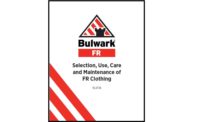Once the right FR clothing is selected for the job, questions might arise on the proper care and maintenance of the garments. Knowing how to properly wash FR clothing will ensure that your safety apparel lasts as long as it should and will protect the way it is meant to. Also, recognizing when your clothing needs to be repaired or replaced is important for safety.
With the right care, FR clothing can last longer and continue to perform as it should. When washed by the prescribed laundry procedures, the durability of the flame resistance of these garments is guaranteed for the useful wear life of the garment.
Following the manufacturer’s instructions is a start, but, according to FR manufacturers, there are some basic care requirements that can be applicable to all FR clothing.
• Wash new garments prior to wearing.
• Don’t use bleach.
• Ensure clothing is clean and in good repair before each wearing.
• Thoroughly remove any oils and flammable contaminants from clothing.
• Repair clothing using only FR fabric, thread and components; return garments to manufacturer for repair or use an authorized repair facility.
Commonly asked questions
1. Should FR clothing be washed separately?
FR manufacturers say clothing doesn’t need to be washed separately unless the garments are soiled with contaminants that you would want to separate from regular clothes.
2. Why can’t I use bleach?
Over time, bleach will break down the molecular bond between the fabric and the FR treatment, according to FR clothing manufacturers. Removing the polymer reduces the flame resistance of the garments. Chlorine bleach will also remove dye from the fiber causing accelerated color loss. Detergents with color safe bleach alternatives are OK but should not be used to launder navy garments because they cause the color to fade.
3. What about other laundry aids?
Starch, fabric softener and other laundry additives can coat the fiber and mask flame resistant performance so manufacturers advise against using them. They could also serve as fuel in case of combustion.
4. Can they be dry cleaned?
Yes, all FR cotton and cotton-blend garments can be dry cleaned as long as no starch is used with exception of FR denim, say FR manufacturers. Do not dry clean FR denim because the indigo dye will fade due to the solvents used in dry cleaning.
5. When is it time to retire an FR garment from service?
According to clothing manufacturers, you should stop wearing the garment if it is torn, ripped, threadbare or frayed around the edges. Also stop use if it is stained with a flammable substance that cannot be removed through laundering. If it has been exposed to flame or electric arc, flammable soil could ignite and continue to burn even though the garment itself won’t burn. Other reasons to stop using the garment are if it has had contact with bleach, has a frayed collar, frayed cuffs or torn, open or frayed seams.
6. How do I keep my garment from shrinking?
Two-thirds of a garment’s shrinkage takes place within the first five washings. If using a dryer is necessary, tumble dry the garment on low. Drying a garment on high heat may shrink it excessively. Most FR clothing includes cotton, which shrinks when it’s washed. Flame resistant fabrics, like many non-FR fabrics, are susceptible to shrinkage no matter what company makes the fabric or manufactures the garment.


